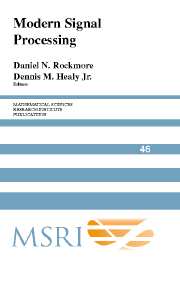Book contents
- Frontmatter
- Contents
- Introduction: A New Generation of Signal Processing
- Hyperbolic Geometry, Nehari's Theorem, Electric Circuits, and Analog Signal Processing
- Engineering Applications of the Motion-Group Fourier Transform
- Fast X-Ray and Beamlet Transforms for Three-Dimensional Data
- Fourier Analysis and Phylogenetic Trees
- Diffuse Tomography as a Source of Challenging Nonlinear Inverse Problems for a General Class of Networks
- An Invitation to Matrix-Valued Spherical Functions: Linearization of Products in the Case of Complex Projective Space P2(ℂ)
- Image Registration for MRI
- Image Compression: The Mathematics of JPEG 2000
- Integrated Sensing and Processing for Statistical Pattern Recognition
- Sampling of Functions and Sections for Compact Groups
- The Cooley-Tukey FFT and Group Theory
- Signal Processing in Optical Fibers
- The Generalized Spike Process, Sparsity, and Statistical Independence
Introduction: A New Generation of Signal Processing
Published online by Cambridge University Press: 25 June 2025
- Frontmatter
- Contents
- Introduction: A New Generation of Signal Processing
- Hyperbolic Geometry, Nehari's Theorem, Electric Circuits, and Analog Signal Processing
- Engineering Applications of the Motion-Group Fourier Transform
- Fast X-Ray and Beamlet Transforms for Three-Dimensional Data
- Fourier Analysis and Phylogenetic Trees
- Diffuse Tomography as a Source of Challenging Nonlinear Inverse Problems for a General Class of Networks
- An Invitation to Matrix-Valued Spherical Functions: Linearization of Products in the Case of Complex Projective Space P2(ℂ)
- Image Registration for MRI
- Image Compression: The Mathematics of JPEG 2000
- Integrated Sensing and Processing for Statistical Pattern Recognition
- Sampling of Functions and Sections for Compact Groups
- The Cooley-Tukey FFT and Group Theory
- Signal Processing in Optical Fibers
- The Generalized Spike Process, Sparsity, and Statistical Independence
Summary
In many ways, the late 1950s marked the beginning of the digital age, and with it, the beginning of a new age for the mathematics of signal processing. Highspeed analog-to-digital converters had just been invented. These devices were capable of taking analog signals like time series (think of continuous functions of time like seismograms which measure the seismic activity — the amount of bouncing — at a fixed location, or an EEG, or an EKG) and converting them to lists of numbers. These numbers were obtained by sampling the time series, that is, recording the value of the function at regular intervals, which at that time could be as fast as 300,000 times every second. (Current technology permits sampling at much higher rates where necessary.) Suddenly, reams and reams of data were being generated and new mathematics was needed for their analysis, manipulation and management.
So was born the discipline of Digital Signal Processing (DSP), and it is no exaggeration to say that the world has not been the same. In the mathematical sciences the DSP revolution has, among other things, helped drive the development of disciplines like algorithmic analysis (which was the impetus behind the creation of computer science departments), communication and information theory, linear algebra, computational statistics, combinatorics, and discrete mathematics. DSP tools have changed the face of the arts (electroacoustic music and image processing), health care (medical imaging and computed imaging), and, of course, both social and economic commerce (i.e., the internet). Suffice to say that the mathematics of DSP is one of the pillars supporting the amazing technological revolution that we are experiencing today.
Information
- Type
- Chapter
- Information
- Modern Signal Processing , pp. ix - xiiPublisher: Cambridge University PressPrint publication year: 2004
